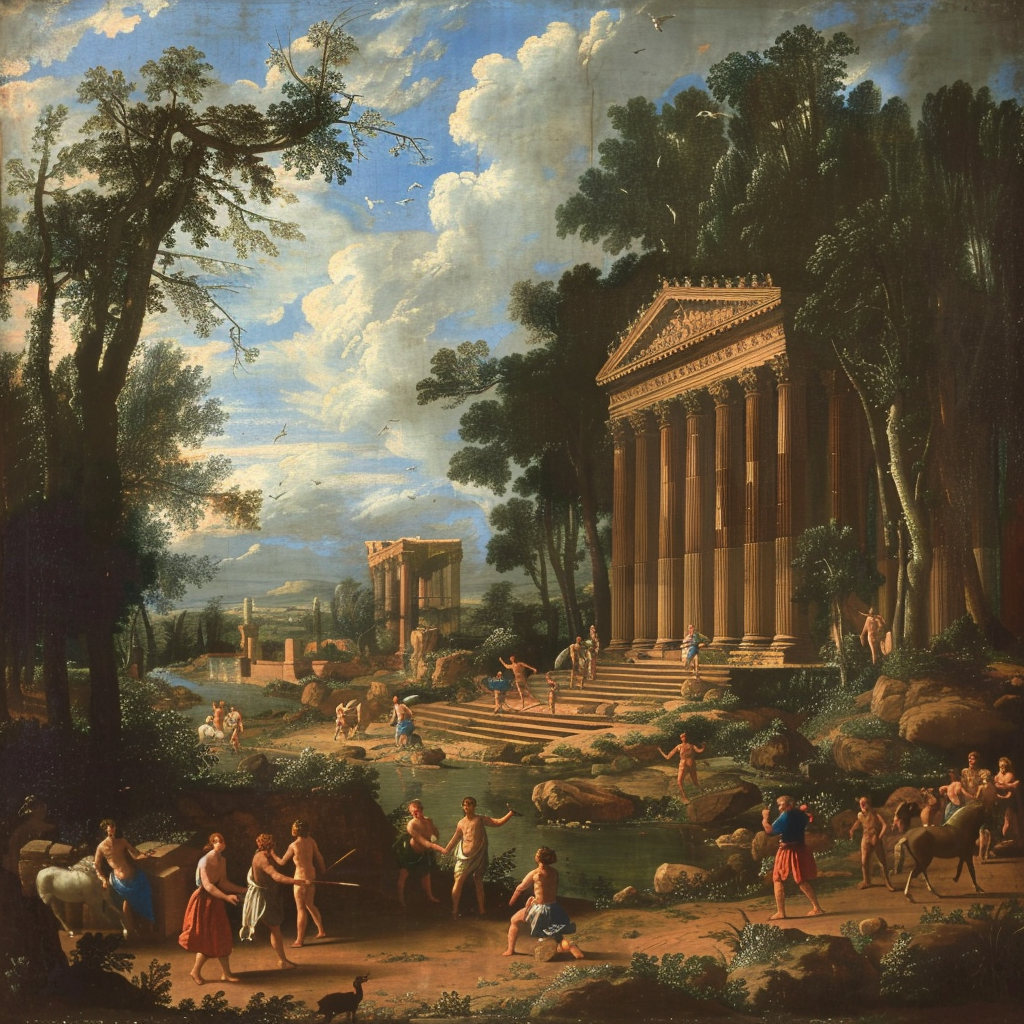The 17th-century French painter Nicolas Poussin saw the spontaneity of Baroque art as lacking in intellectual thought and sought the idealized, timeless beauty of ancient Greco-Roman art. He created works based on reason, demanding deep thought and reflection from the viewer.
The 17th-century French painter N. Poussin sought to represent through his paintings the eternal essence and ideal beauty that lies beyond the empirical dimension. His artistic philosophy went beyond mere aesthetic expression and was the result of deep thought that explored the nature of human existence and sought to find the ideals hidden within it. His artistic philosophy went beyond mere aesthetic expression to explore the nature of human existence and find the ideals hidden in it, and this allowed his works to reach out to the viewer beyond mere visual pleasure.
The era in which he lived was dominated by Baroque art, which he characterized as an artistic activity lacking in intellectual thought because it primarily represented the artist’s spontaneous emotions. He sought to find the principles of beauty in the classical tradition of ancient Greco-Roman art, which sought ideal beauty and eternal constancy, instead of distancing itself from chance and change. Foussaint believed that reason was the ability to grasp the universal principles of nature, and since ancient Greco-Roman art was based on reason, he believed that ancient art could provide universal principles that could be applied to all times.
Therefore, he used mythological, historical, or biblical stories, which were the main subjects of ancient art, as the subject matter of his paintings, and used restrained and compressed expressions, transforming them into poetry rather than narrative. To this end, he thoroughly excluded any elements that might distract the viewer’s gaze. In representing the figures in his works, he chose the most idealized figures from ancient statues that he thought best suited his expressive intentions, and placed them in artificial postures to best reveal the subject matter. In composing his works, he applied the principles of balance and symmetry based solely on the laws of reason, and the principles of geometric spatial organization using lines and shapes to create a cohesive and stable composition. He considered the eternal essence of nature to be harmony and order, which he sought to embody in his paintings.
Poussin’s artistic approach was also closely related to the cultural and philosophical context of his time. Seventeenth-century Europe was a time of reason and rationalism, with philosophers such as René Descartes making reason the foundation of all knowledge. Influenced by this philosophical trend, Poussin emphasized the role of reason in art. He believed that art should be understood and interpreted through reason, not merely as a sensory experience. His works are therefore not merely pleasing to the eye, but demand deep thought and reflection from the viewer.
Poussin’s efforts to convey timeless essences and idealized beauty through these principles of representation are as evident in his landscape paintings as they are in his other works. He sought to represent the universal essence of human life by using the lives of heroic figures from history as subjects for his works and by imposing a strict order and harmony on the landscape. His landscapes feature natural settings and specially selected architecture. The natural landscapes in his works are not realistic representations of nature, but rather the most idealized and essential images of nature that Foussaint believes in, and ancient architecture is also used as part of the background to show its idealized beauty. Against this backdrop, he imposed a strict order and harmony on nature by using a clear division of foreground, middle ground, and background, symmetry of left and right, a gradual spatial transition from foreground to background, and a geometric order of horizontal and vertical. Thus, by using the lives of heroic figures as his subject matter, he sought to select only the great and extraordinary from nature to represent the essence of life that humans should universally pursue.
Poussin’s artistic vision is consistently reflected in his work, and for him, art is the result of a conscious endeavor, in that he sought to codify his principles of expression into clear laws and apply them strictly to all his works. For this reason, the aesthetic pleasure that viewers experience from his work is more intellectual and spiritual than sensory. Furthermore, his works do more than just provide visual satisfaction to the viewer; they enrich their inner world and prompt them to ask deep philosophical questions. This is in line with Foussaint’s ultimate goal of art. Art is not a mere decoration, but a means to explore the essence of human existence and, through that essence, to reach a higher ideal.

Foucault’s artistic philosophy has had a great influence on many artists since. His classical approach inspired artists of the Enlightenment and Neoclassicism in the 18th century, and remains an important aesthetic reference in the modern era. His work has timeless aesthetic value and continues to resonate with many people today. Poussin’s art is not just a legacy of the past, but a valuable asset for the present and future.
Foussaint’s artistic legacy is not limited to his works of art. His philosophy and approach offer new perspectives on art education, aesthetic studies, and art appreciation. Today, many artists and art lovers are inspired by his work, and his artwork still holds an important place in museums and galleries around the world. This is a testament to the enduring value of Poussin’s art and the profound impression he left on the art world.
 I’m a blog writer. I want to write articles that touch people’s hearts. I love Coca-Cola, coffee, reading and traveling. I hope you find happiness through my writing.
I’m a blog writer. I want to write articles that touch people’s hearts. I love Coca-Cola, coffee, reading and traveling. I hope you find happiness through my writing.